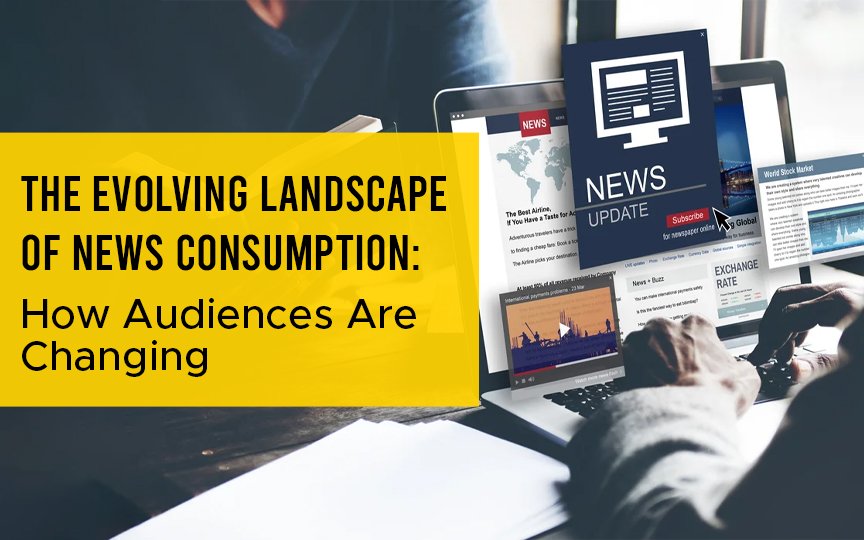The dinner table debates fueled by the evening news are a relic of the past. Today’s news consumers are a dynamic and diverse bunch, consuming information on the go, across a multitude of platforms. The once-dominant role of traditional media outlets – newspapers, and television news broadcasts – is facing a significant transformation in the face of this evolving landscape.
Let’s delve into the key trends shaping how audiences consume news today:
1. The Rise of Digital Dominance:
The internet revolutionized news consumption. Gone are the days of waiting for the morning paper or the nightly newscast. News is now just a tap or click away, accessible 24/7 on smartphones, tablets, and laptops. This immediacy and accessibility have fundamentally changed how people engage with news. Breaking news can go viral within minutes, and in-depth analysis is readily available from a vast array of online sources.
2. A Buffet of Information Sources:
The internet has democratized news production. Traditional media outlets still hold a place, but they now compete with a plethora of online news websites, blogs, podcasts, and social media feeds. This fragmentation of the news landscape empowers audiences to curate their personalized news diet, choosing sources that align with their interests and perspectives.
3. The Power of Social Media:
Social media platforms like Facebook, Twitter, and Instagram have become powerful news aggregators and distributors. They provide a constant stream of headlines, news snippets, and even live broadcasts, blurring the lines between professional journalism and user-generated content. While this immediacy keeps users informed, it also raises concerns about verification and the spread of misinformation.
4. The Age of Personalization:
News algorithms on platforms like Facebook and Google News personalize content feeds based on user behavior and past consumption patterns. This can create “echo chambers,” where users are primarily exposed to information that confirms their existing beliefs. This raises concerns about filter bubbles that limit exposure to diverse viewpoints and hinder critical thinking.
5. Shifting Trust Landscape:
The traditional trust people placed in established news organizations is eroding. The proliferation of fake news and the rise of partisan media outlets have made it difficult for audiences to discern reliable information from biased or fabricated content. This has led to a growing trend of news skepticism, where audiences actively question the sources and motivations behind the news they consume.
How are News Organizations Adapting?
Traditional media outlets are facing a crucial test of their adaptability. To remain relevant, they are embracing these changes in several ways:
- Digital Transformation: Newspapers and TV channels are strengthening their online presence, creating user-friendly websites and mobile apps.
- Focus on Multi-Platform Delivery: News organizations are delivering content across various platforms – websites, social media, podcasts, video streaming – to reach audiences where they are.
- Interactive Storytelling: News outlets are experimenting with interactive formats like quizzes, polls, and live chats to engage audiences in a more participatory way.
- Data-Driven Content: News organizations are leveraging data analytics to understand their audience better and personalize content recommendations.
- Focus on Credibility: In a world of misinformation, establishing and maintaining trust is paramount. Reputable organizations are doubling down on fact-checking, investigative journalism, and in-depth reporting.
The Future of News Consumption
The future of news consumption is likely to see a continuation of these trends. Here are some additional possibilities:
- The rise of niche news platforms: Catering to specific interests and communities.
- Paywalls for premium content: News organizations might offer in-depth, ad-free content behind paywalls to generate revenue.
- The increasing importance of visual storytelling: With shorter attention spans, visually engaging formats like video and infographics might become the preferred way to consume news.
- The role of AI: Artificial intelligence could play a growing role in news curation and personalized news delivery.
Challenges and Opportunities
News organizations, meanwhile, need to prioritize journalistic integrity, transparency, and audience engagement to regain trust.
Ultimately, the power lies with the audience. By becoming active participants in the information ecosystem, demanding high-quality journalism, and holding news organizations accountable, audiences can ensure that they have access to the reliable information they need to be informed citizens in a complex world.
This rapidly evolving landscape presents both challenges and opportunities for news consumers. It’s vital to develop critical thinking skills to assess the credibility of information sources. Seeking diverse perspectives and verifying information before sharing is essential in the fight against misinformation.
The Evolving Landscape for Students Of Mass Communication
Currently, students who are pursuing Mass Communication or a Master’s degree in Mass Communication and Journalism are more eager to learn about both traditional media and digital media. They try to make the most out of both programs by studying the media that was being taught then and applying it to the modern digital age.
In today’s era of online education, traditional modes of learning have been left behind. There are now some of the best online communication master’s programs available for learners which are no less than the programs offered in regular colleges. It is the best way to learn about media and journalism. As we are moving towards digital media, learning it online can only offer more advantages.
This generation spends more time on screens than in the present moment. Why not use this time for learning?







